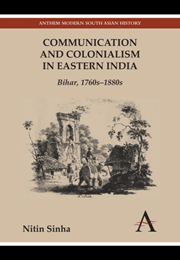Book contents
- Frontmatter
- Contents
- Acknowledgements
- List of Abbreviations
- Glossary
- List of Tables and Illustrations
- Introduction
- Chapter 1 From Affective Forms to Objectification: Spatial Transition from Pre-colonial to Colonial Times
- Chapter 2 India and its Interiors
- Chapter 3 Going into the Interiors
- Chapter 4 Knowing the Ways
- Chapter 5 Controlling the Routes
- Chapter 6 Changing Regime of Communication, 1820s–60s
- Chapter 7 Of Men and Commodities
- Chapter 8 The Wheels of Change
- Conclusion
- Bibliography
- Index
Chapter 6 - Changing Regime of Communication, 1820s–60s
Published online by Cambridge University Press: 05 February 2013
- Frontmatter
- Contents
- Acknowledgements
- List of Abbreviations
- Glossary
- List of Tables and Illustrations
- Introduction
- Chapter 1 From Affective Forms to Objectification: Spatial Transition from Pre-colonial to Colonial Times
- Chapter 2 India and its Interiors
- Chapter 3 Going into the Interiors
- Chapter 4 Knowing the Ways
- Chapter 5 Controlling the Routes
- Chapter 6 Changing Regime of Communication, 1820s–60s
- Chapter 7 Of Men and Commodities
- Chapter 8 The Wheels of Change
- Conclusion
- Bibliography
- Index
Summary
Broadly summarizing, so far we have covered the ‘history of communication’ from three perspectives: one, the nature and policies of the early colonial state towards communication between the 1760s and 1820s; two, the formation of a knowledge pool about roads and routes; and, three, the regulative measures adopted towards certain mobile groups. In evaluating the policies adopted towards communication we looked closely at the nature of trade, which influenced if not completely determined the course of action. We noticed the formation of one trunk line, the NMR, and also a growing interest in improving district-level communication networks. We argued (see Chapter 2) that a growing conviction in the idea of ‘roadless India’ became strong from the 1820s. This chapter carries the story forward into the next four decades until the railways come into the picture. An ardent belief in lack/absence/inadequacy of communication and the need for improvements propelled the colonial state to invest in public works during the period under review. This was the time when the GTRs were made and ferry communication was improved. Unfortunately, the colonial emphasis on railway building from the 1840s has also affected the historiography of transport in India. This is arguably because of the litany of discourse that divided Indian history into pre-steam and poststeam; needless to say, the latter represented recent ‘modern’ technology, promising a change in society and economy. In accounts following such divisions, the binary of old and new is reiterated.
- Type
- Chapter
- Information
- Communication and Colonialism in Eastern IndiaBihar, 1760s-1880s, pp. 155 - 180Publisher: Anthem PressPrint publication year: 2012



